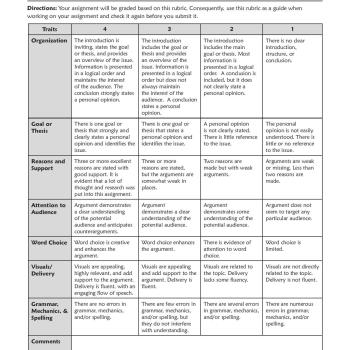RUBRIC FOR A PERSUASIVE PRESENTATION
Dr. elise gold (engineering).
Below you will find the various criteria used to evaluate your presentation along with categories describing your performance in these areas. The boxes highlighted indicate your overall performance in the broader areas as described. Items specifically needing work may be underlined. Along with a grade, an overall evaluation follows, with a few major suggestions for improvement.
|
|
|
|
| |
| Presentation was excellent overall, shows outstanding control and skill, exceeds expectations in meeting the assignment’s requirements. | Presentation was very good overall, shows good control and skill, exceeds expectations in meeting most of the assignment’s requirements. | Presentation definitely showed strengths outweighing weaknesses, is meeting a number of the assignment’s requirements. | Presentation, though not developed enough with major weaknesses apparent, has begun to meet some of the assignment’s requirements. | Presentation exhibited consistent weaknesses throughout, isn’t meeting the assignment’s requirements. |
| Speaker captured and maintained audience=s attention and anticipated and addressed questions, needs, interests, knowledge well. | Speaker achieved most of the aspects listed. | Speaker achieved many of the aspects listed. | Speaker has begun to achieve some of aspects listed. | Speaker did not achieve most of aspects listed. |
| In the introduction, speaker used good attention grabber, gave overview clearly indicating organization and content, and spoke strongly, emphatically, and confidently. Speaker effectively ordered major sections of the presentation in a logical, easy-to-follow manner; provided clear transitions from one section to the next, and used repetition as necessary to clarify and make points memorable. Speaker adequately signaled the end of presentation so listeners were not surprised, restated and drove main points home, left listeners with a lasting impression. | Speaker achieved most of the aspects listed. | Speaker achieved many of the aspects listed. | Speaker has begun to achieve some of aspects listed. | Speaker did not achieve most of aspects listed. |
| Speaker effectively explained the controversial topic and its significance; presented appropriate background information, commenting on the problem’s causes/effects; clearly identified his/her position/proposal for change, opposing points and points in favor in a logical manner; supported points with reference to source materials consulted; and limited number of main points. | Speaker achieved most of the aspects listed. | Speaker achieved many of the aspects listed. | Speaker has begun to achieve some of aspects listed. | Speaker did not achieve most of aspects listed. |
| Speaker remembered to solicit questions without awkward delay, welcoming them with confidence; showed questioners respect, repeated questions and asked for clarification as needed; responded clearly and precisely, elaborated well; maintained composure even with some tough questions, admitted lack of knowledge gracefully and offered to follow up rather than bluffs. | Speaker achieved most of the aspects listed. | Speaker achieved many of the aspects listed. | Speaker has begun to achieve some of aspects listed. | Speaker did not achieve most of aspects listed. |
| Speaker used relevant visuals containing sufficient information (not too little, not too much) which enhanced rather than detracted from the presentation points (that is, not focused on graphics or PowerPoint “bells and whistles”; smoothly integrated visual/s, revealing points one by one; provided easily readable, attractively and functionally well designed, and professional-looking visuals with effective bulleting, clear font style and size, good use of space, and consistent look; kept visuals free of grammatical errors (i.e., missing end punctuation, faulty parallelisms, inconsistencies in outline format and capitalization, etc.); credited source/s of information and/or graphics correctly; knew how to use equipment well; had back-up plan if visuals fail; looked at audience not at visuals. | Speaker achieved most of the aspects listed. | Speaker achieved many of the aspects listed. | Speaker has begun to achieve some of aspects listed. | Speaker did not achieve most of aspects listed. |
| Speaker’s delivery added to rather than detracted from talk; he/ she obviously rehearsed rather than hardly practiced; delivered with brief references to notes rather than read a prepared script; kept close to the time limit (not much under or over). | Speaker achieved most of the aspects listed. | Speaker achieved many of the aspects listed. | Speaker has begun to achieve some of aspects listed. | Speaker did not achieve most of aspects listed. |
| Speaker talked loudly enough and paced presentation well (not too slow or fast), avoiding halting speech, mumbling, trailing off at ends of sentences; conveyed enthusiasm for subject; used varied expression and good enunciation; avoided using fillers (Aum,@ Auh,@ Alike,@ etc.) and making major or frequent stumbles and/or becoming flustered by them.
Speaker chose an appropriate level of language, avoided heavy use of jargon, used technical language clearly, chose words well, spoke grammatically correct, and used good pronunciation.
Speaker appeared comfortable, had good posture (i.e., avoided leaning on lectern); faced the audience and made eye contact throughout; gestured appropriately and avoided distracting tics (i.e., weight shifting or rocking, scratching, touching face or hair, playing with/ straightening/banging note cards or sheets, putting hands in or pulling them out of pockets, playing with paper clips, jingling keys, etc.) | Speaker achieved most of the aspects listed. | Speaker achieved many of the aspects listed. | Speaker has begun to achieve some of aspects listed. | Speaker did not achieve most of aspects listed. |
GRADE: _________
(Points lost for not showing up for presentation, not submitting copy of presentation outline, notes, and handout copy of slides on day of presentation for not being present to serve as a peer=s assigned questioner? __________)
OVERALL EVALUATION:

Persuasion Rubric

About this printout
Use this rubric to assess the effectiveness of a student's essay, speech, poster, or any type of assignment that incorporates persuasion.
Teaching with this printout
More ideas to try, related resources.
Grading rubrics can be of great benefit to both you and your students. For you, a rubric saves time and decreases subjectivity. Specific criteria are explicitly stated, facilitating the grading process and increasing your objectivity. For students, the use of grading rubrics helps them meet or exceed expectations, to view the grading process as being “fair,” and helps them set goals for future learning. In order to help your students meet or exceed expectations of the assignment, be sure to discuss the rubric with your students when you assign a persuasion project. It is helpful to show them examples of pieces that meet and do not meet the expectations. As an added benefit, because the criteria are explicitly stated in the rubric, the use of it decreases the likelihood that students will be confused about the grade they receive. The explicitness of the expectations helps students know exactly why they lost points on the assignment and aids them in setting goals for future improvement. Use the Visuals/Delivery category to grade audio and visual elements in speeches, PowerPoint presentations, blogs, posters, skits, podcasts, or any other assignment where visuals and delivery play roles. If your assignment does not require speech or visuals, simply disregard this part of the rubric.
- Routinely have students score peers’ work using the rubric as the assessment tool. This increases their level of awareness of the traits that distinguish successful persuasive projects from those that fail to meet the criteria.
- Alter some expectations or add additional traits on the rubric as needed. For example, if the assignment is to create a persuasive podcast, criteria such as articulation, communication, sound effects, and audio clarity may be added. You may also adapt the criteria to make it more rigorous for advanced learners and less stringent for lower level learners. In addition, you may want to include content-specific criteria for your subject area.
- After you and your students have used the rubric, have them work in groups to make suggested alterations to the rubric to more precisely match their needs or the parameters of a specific persuasive assignment. For example, if you wanted them to work in cooperative groups to write and present persuasive skits, possible criteria could include teamwork and the length of the skit.
- Lesson Plans
- Student Interactives
- Strategy Guides
Through a classroom game and resource handouts, students learn about the techniques used in persuasive oral arguments and apply them to independent persuasive writing activities.
The Persuasion Map is an interactive graphic organizer that enables students to map out their arguments for a persuasive essay or debate.
- Print this resource
Explore Resources by Grade
- Kindergarten K
Module Eight: Delivering Your Persuasive Speech
Sample rubric: persuasive speech.
Delivery [40]
____Verbal Elements (19)
– Effective use of memory (3) Effective [ ] Ineffective: Read [ ] Somewhat Read [ ] Other [ ] _____
– Intelligibility (3) Effective [ ] Ineffective: Rate: Fast [ ] Slow [ ] Volume: Low [ ] Pronunciation [ ] Enunciation [ ] Other [ ] _____
– Emotional Expression & Tone (3) Effective [ ] Ineffective: Monotone [ ] Read [ ] Other [ ] _____
– Good vocal modulation (10) – talking loud enough and clearly, talking at an effective rate of speed
____Nonverbal Elements (11)
– Eye Contact (6) Effective [ ] Ineffective: Reading [ ] Fixed Point [ ] Missing: Left [ ] Right [ ] Other [ ] _____
– Overall Poise (3) Effective [ ] Ineffective: Swaying [ ] Fidgeting: Legs [ ] Hands [ ] Informal [ ] Other [ ] _____
– Facial Expression (1) Effective [ ] Ineffective [ ] Missing [ ]
– Gesticulation & Motivated Movement (1) Effective [ ] Ineffective [ ] Missing [ ]
____Effective use of presentation aides (10)
Structure [30]
____Macro (20)
– Introduction (4)
– Listener Relevance (1) Effective [ ] Ineffective [ ] Missing [ ]
– Credibility Statement (1) Effective [ ] Ineffective [ ] Missing [ ]
– Thesis Statement (1) Effective: Fact [ ] Value [ ] Policy [ ] Ineffective: Missing Persuasive Element [ ] Missing [ ]
– Preview of Main Points (1) Effective [ ] Ineffective [ ] Missing [ ]
– Transitions (2) Effective [ ] Ineffective [ ] Missing [ ]
– Conclusion (4) Thesis Restatement, Summary, Clincher
– Thesis Restatement (1) Effective: Fact [ ] Value [ ] Policy [ ] Ineffective: Missing Persuasive Element [ ] Missing [ ]
– Summary of Main Points (1) Effective [ ] Ineffective [ ] Missing [ ]
– Clincher (2) Effective [ ] Ineffective: Missing Persuasive Element [ ] Missing [ ]
– Effectively used storytelling to gain/keep audience attention (8)
____Micro (10)
– Language (3) Effective [ ] Ineffective: Unclear [ ] Slang [ ] Informal [ ] Jargon [ ] Undefined [ ] Exclusive [ ]
– Ineffective Fillers (7) Avoided [ ] Ineffective: Pauses [ ] Um [ ] Uh [ ] And [ ] So [ ] Like [ ] You Know? [ ] Other [ ] ____
Content [ 30]
____Use of Monroe’s Motivated Sequence (25)
– Gained our attention (5)
– Established the Need (5)
– Proposed a Solution (5)
– Helped us visualize the world with/without this solution (or both) (5)
– Offered a clear and specific call to action (5)
____Supporting Evidence (5)
– Citations (2) Evident [ ] Missing [ ] – Integration (2) Effective [ ] Ineffective [ ] Missing [ ]
________Time (Docked 5 points for every 30 seconds you are under four minutes or over six minutes)
- Persuasive Speech Rubric. Authored by : Christie Fierro. Provided by : Tacoma Community College. Located at : http://www.tacomacc.edu/ . Project : Kaleidoscope Open Course Initiative. License : CC BY: Attribution
- help_outline help
iRubric: Persuasive Speech rubric
| Rubric Code: By Ready to use Public Rubric Subject: Type: Grade Levels: 9-12 |
| Persuasive Speech Speech writers write a persuasive speech and present it in the role of the candidate. | ||||
| | ||||
| | ||||
| | ||||
| | ||||
| | ||||
- Rhetorical devices
- Presentation
- Rating Count
- Price (Ascending)
- Price (Descending)
- Most Recent
Persuasive paragraph rubric
Resource type.

Persuasive Paragraph Rubric

Persuasive Paragraph Graphic Organizer l Example and Teacher Rubric Included

5 Paragraph Persuasive Essay & Propaganda Assignment (with rubric )

AP Spanish Persuasive Paragraph Assessment with Study Guide and Rubric

Vaccine 5 Paragraph Persuasive Essay Rubric

Persuasive 5 Paragraph Essay graphic organizers and rubric

Persuasive /Expository 5 Paragraph Graphic Organizer and Rubric


5 Paragraph Persuasive Essay Rubric

Persuasive Paragraphs Rubric

Persuasive Essay 4- paragraph rubric

5 Paragraph Persuasive Essay Rubric (standards aligned)

Persuasive Essay Body Paragraph Rainbow Success Rubric

Rubric - 5 Paragraph Persuasive Essay

Paragraph Writing Prompts Process Posters Narrative Persuasive Opinion Checklist

Paragraph Writing How to Write a Paragraph of the Week 2nd 3rd 4th Grade Prompts

Writing Rubrics - Paragraph Rubrics - Essay Rubrics - 1 Point Rubric

Persuasive Writing - Graphic Organizers, Planning Pages and Rubrics

Opinion Writing 5 Paragraph Essay Differentiated Persuasive Writing

Persuasive Essay Outline - Writing Assignment and Graphic Organizer OSSLT OLC4O

Hire Me 5- Paragraph Persuasive Essay: Christmas Elf Argumentative Writing Prompt

I Want a Pet Paragraph Packet | Persuasive Paragraph Writing

Narrative and Persuasive Writing Worksheet Bundle

- We're hiring
- Help & FAQ
- Privacy policy
- Student privacy
- Terms of service
- Tell us what you think

IMAGES
COMMENTS
PERSUASIVE SPEECH RUBRIC. As you listen to the speech, circle the number for each category (Introduction, Content, Delivery, Conclusion, Overall) that you think best describes how that part of the speech went. Add up your numbers and write the total score at the bottom of this page. The first few lines of the speech really got my attention and ...
Persuasive Speech Rubric Give this form to your instructor before you give your speech
Along with a grade, an overall evaluation follows, with a few major suggestions for improvement. EXCEPTIONAL: A. STRONG: AB. EFFECTIVE: B. DEVELOPING: BC/C. INADEQUATE: D/F. MAJOR CRITERIA FOR EVALUATION. Presentation was excellent overall, shows outstanding control and skill, exceeds expectations in meeting the assignment's requirements.
Persuasion Rubric Directions: Your assignment will be graded based on this rubric. Consequently, use this rubric as a guide when working on your assignment and check it again before you submit it.
Routinely have students score peers' work using the rubric as the assessment tool. This increases their level of awareness of the traits that distinguish successful persuasive projects from those that fail to meet the criteria. Alter some expectations or add additional traits on the rubric as needed. For example, if the assignment is to ...
Persuasive Presentation Rubric Additional Comments
Sample Rubric: Persuasive Speech Delivery [40] ____Verbal Elements (19) - Effective use of memory (3) Effective [ ] Ineffective: Read [ ] Somewhat Read [ ] Other [ ] _____ - Intelligibility (3) Effective [ ] Ineffective: Rate: Fast [ ] Slow [ ] Volume: Low [ ] Pronunciation [ ] Enunciation [ ] Other [ ] _____
Persuasive Speech Grading Rubric Introduction
Persuasive Speech Rubric © www.learningtogive.org
Persuasive Speech Rubric. Name: AREA GRADED 10. Excellent 9. Above Average 8. Average 7. Below Average 6. Failing AREA 1: TOPIC ... ORAL PRESENTATION RUBRIC Author: BOCES BOCES Last modified by: tbahne Created Date: 11/10/2010 3:04:00 PM Other titles: ORAL PRESENTATION RUBRIC ...
Persuasive Speeches. This lesson is the best tool you could use to design your rubric for assessing students' persuasive speeches. It will be specific enough to help set expectations for your ...
Score/Criteria 4 There is a clear position statement, supported by reasonable arguments. The speaker's body language is not distracting to the listener. Words are correctly used and pronounced, avoiding slang expressions. The speaker avoids a monotone and speaks slowly and loudly enough to be understood. The point of view is convincing.
TOTAL /20 not near the beginning. paper just ends.
iRubric KX625C7: Students are assessed on their abilities to use appeals, rhetorical devices and commentary to persuade their audience.. Free rubric builder and assessment tools.
The rubric evaluates persuasive speeches on several criteria: 1) Time requirements - speeches must be within certain time limits to receive full points. 2) Research quality - more research and credible sources result in higher scores. 3) Referencing sources - sources must be clearly identified to receive full points. 4) Structure and suitability for audience - the speech must be structured as ...
This document contains a rubric for evaluating persuasive speeches with criteria in five areas: focus, content, organization, body language, and vocal projection. Speeches are scored from 1-5 or 16-20 depending on how well they meet the standards in each criteria, such as having a clear thesis, providing credible evidence, maintaining eye contact, and speaking at an appropriate rate and volume ...
This document provides a rubric for evaluating persuasive speeches. It is divided into sections that assess the outline, introduction, body, conclusion, delivery, and overall impression of the speech.
Persuasive Speech Rubric 16 Ratings ; Grade Levels 7th - 12th, Higher Education, Homeschool Subjects English Language Arts, Communications Resource Type Assessment, Rubrics Formats Included Word Document File Pages 2 pages $1.00 Add one to cart Buy licenses to share Wish List Share this resource Report this resource to TPT The Lit Guy 710 ...
A four-level rubric for assessing students' persuasive/argumentative presentations. The rubric is split into the following categories: - Research - Content - Syntax and Professionalism - Cooperative Group Work...
This rubric evaluates persuasive speeches on multiple criteria in four categories: exceptional/skilled, proficient, developing/inadequate. It assesses elements like the attention grabber, topic, thesis, subject knowledge, rhetorical appeals, conciliation, organization, credibility, delivery techniques, and the final draft. Speeches are scored on a 100-point scale, with exceptional performances ...
Use this no-prep Google Slides presentation with examples, a video, graphic organizers, and a rubric to help guide your students to a perfect paragraph. This Persuasive Paragraph Google Slides has 17 pages of great information about how to write a persuasive paragraph - including the topic sentence, supporting details, commentary, and ...
The document provides an analytic rubric for evaluating persuasive speeches. It outlines four levels of performance - Excellent, Satisfactory, Developing, and Beginning - across five criteria: introduction, thesis statement, overall organization, and volume and clarity. For each criteria, it describes the characteristics that would qualify a speech for each performance level.
investigators for inducing prosecution in retaliation for speech." 547 U.S. at 252. The defendants, federal officials sued in their individual capacities, moved for ... ut of deference to the rubric Congress has created, . . . any request for ... Supreme Court dicta as "highly persuasive" (quotations omitted)). Appellate Case: 22-1453 ...
The document provides a rubric for evaluating persuasive presentations with criteria in several areas: content, organization, logical development, style, delivery, motivational sequence, and credibility. An exemplary presentation would have clear and well-supported content directly related to the thesis, a natural organization and flow, a logical sequence of ideas, creative use of rhetorical ...